Keyword Golden Ratio (KGR) calculator
On this page
Introduction
When it comes to SEO, pinpointing the optimal keywords is essential. These keywords are what make your content discoverable to potential readers and influence your site's standing on the Search Engine Results Pages (SERPs). Today, we're diving into an influential SEO tool—the Keyword Golden Ratio (KGR) calculator. This tool empowers you to spot and capitalize on under-saturated keywords, propelling your website's ranking forward.
KGR, a concept introduced by Doug Cunnington of Niche Site Project, zeroes in on long-tail keywords that may not have high search volumes but offer less competition. Often ignored by major players, these keywords present prime opportunities for smaller sites and those just entering the market.
Utilizing the Keyword Ratio Analysis tool, you can effortlessly determine the KGR for any keyword, guiding your decision to create content around it. KGR, also referred to as KGROI (Keyword Golden Ratio Index), serves as a reliable measure of a keyword's potential.
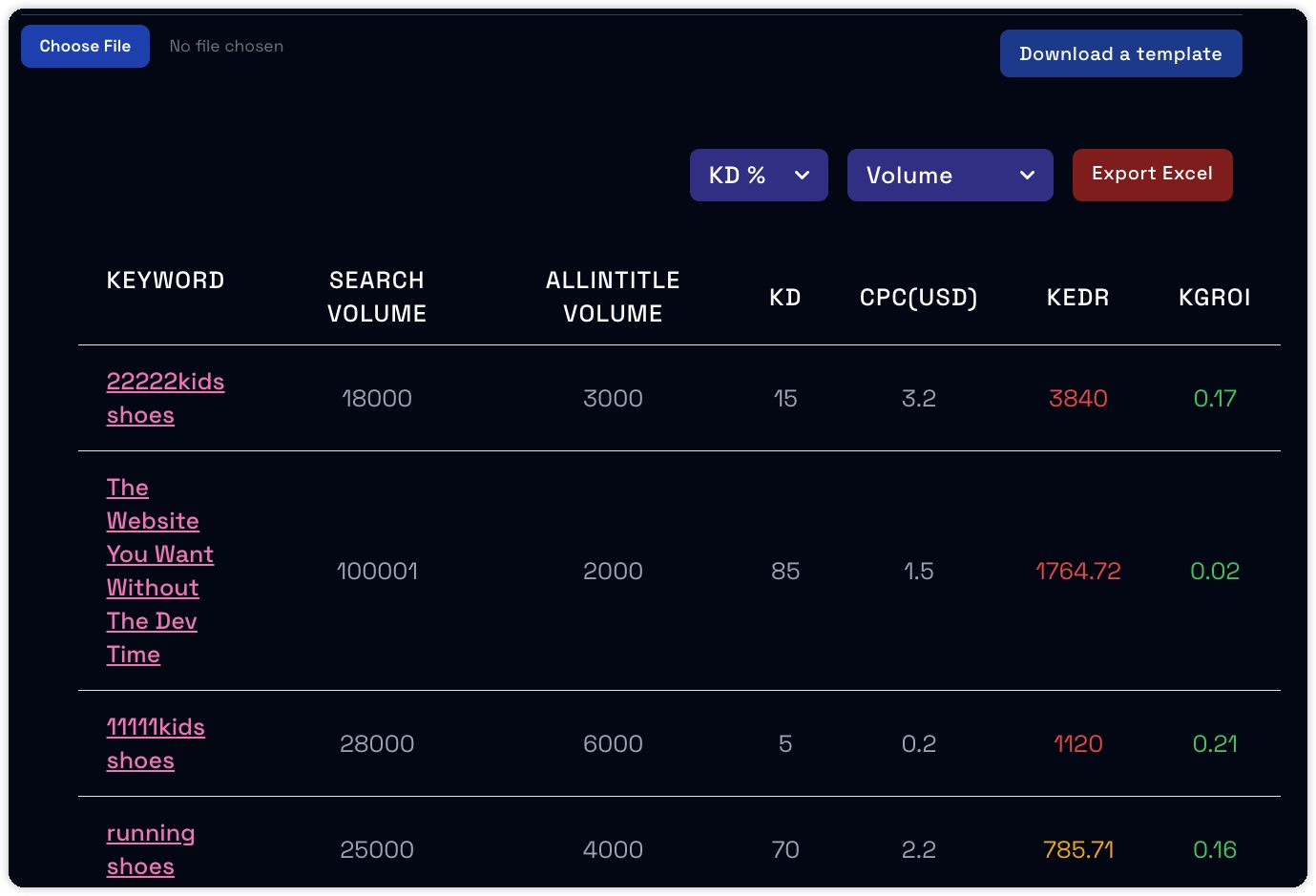
As we progress, we'll unpack the role of KGR in SEO, its calculation, and its application in enhancing your website's content. We'll also offer practical calculation examples to deepen your grasp and application of this concept. Whether you're new to SEO or a seasoned pro, grasping KGR will bolster your content strategy with a formidable asset.
Let's embark on our journey into the intricacies of KGR and discover how it can elevate your content above the search engine noise.
What Does KGR Mean for SEO
When it comes to SEO, pinpointing the optimal keywords is key. The Keyword Golden Ratio (KGR) is a vital SEO indicator that can uncover under-saturated keywords. This concept, introduced by Doug Cunnington of Niche Site Project, is designed to uncover keywords that have been ignored by competitors due to their low search volume.
Core Concept of KGR
At the heart of KGR is the balance between supply and demand. If the quantity of content ranking for a keyword on the Search Engine Results Pages (SERPs) surpasses the number of searches for that keyword, then supply is outpacing demand. This is common with trending keywords. In contrast, the KGR approach targets keywords where the supply of content is less than or equal to the demand.
The Potential of Long-Tail Keywords
KGR often aligns with long-tail keywords, which are extended phrases typically comprising four or more words. Despite their lower search volumes, these keywords offer less competition, making them prime candidates for the KGR strategy.
How to Identify KGR Keywords
Identifying KGR keywords involves locating a keyword with a monthly search volume of 250 or fewer, and ensuring there are under 63 title results (as indicated by Google's advanced search operator allintitle). These metrics signal less competition and a higher chance of achieving a top ranking.
Focusing on KGR keywords allows websites to strategically enhance their SEO efforts, increase their search engine visibility, and consequently, draw in more organic traffic. In the subsequent sections, we will explore the process of calculating KGR, offering practical steps and examples to guide you in harnessing this potent SEO tool.
How KGR Works
The Keyword Golden Ratio (KGR) operates on a simple yet potent principle. Here's how you can implement the KGR approach:
-
Identify Relevant Keywords: Start by pinpointing a keyword with a monthly search volume around 250 or less. These tend to be long-tail keywords that face less competition, potentially securing a higher placement on the Search Engine Results Pages (SERPs).
-
Inspect Title Results: Conduct a search using Google's advanced search operator
allintitle:with your keyword to confirm that there are less than 63 title results. This threshold is crucial to the KGR strategy, as it indicates the current number of pages optimized for that keyword. -
Craft High-Quality Content: After identifying a suitable KGR keyword, your team should craft and publish content that is both high-quality and keyword-rich. The content should not only feature the target keyword but also offer meaningful value to readers.
-
Capitalize on Low Competition: With the reduced competition for your targeted keyword, the content you produce is more likely to achieve a prominent ranking on the SERPs. This can lead to a swift surge in your organic traffic.
KGR Calculation Formula
The formula for calculating KGR is straightforward and explicit:
KGR = (Title Result Count / Monthly Local Search Volume)
- Title Result Count: Refers to the total number of pages containing your keyword as determined by a Google search using the
allintitle:operator. - Monthly Local Search Volume: This is the frequency of searches for a particular keyword within a given timeframe, typically a month, and can be sourced from various third-party SEO utilities.
A lower KGR score indicates that there is less content available for that keyword, meaning your content has a higher probability of ranking higher on the SERPs in relation to the demand. The goal is to target keywords with a KGR score below 0.25.

This formula offers a definitive quantitative measure for SEO, assisting website proprietors and content creators in concentrating their efforts on keywords that are most likely to generate traffic.
In the subsequent section, we will delve into the metrics of KGR and learn how to leverage these metrics to refine your SEO tactics.
KGR Metrics
The KGR metric serves as a pivotal measure for assessing the potential of keywords, factoring in both their search volume and the quantity of title results. Here are some key insights into KGR metrics:
Monthly Search Volume
- Approximately 250: The ideal KGR keywords generally have a monthly search volume around 250 or fewer. There's some leeway in this figure, but ideally, it should not surpass 500 to keep the competition low.
KGR Score
- Less than 0.25: A KGR score below 0.25 suggests that your keyword is highly likely to achieve a prominent ranking on search engines.
- Between 0.25 and 1.00: Scores in this range indicate a moderate probability of your keyword achieving a high ranking.
- Above 1.00: A KGR score exceeding 1.00 signifies a reduced likelihood of your keyword ranking prominently.
KGR Calculation Example
Consider a keyword with 63 title results and a monthly search volume of 250. Using the KGR formula, we get:
KGR = (Title Result Count / Monthly Local Search Volume)= 63/250 = 0.252
Here, the KGR value of 0.252 is marginally above the optimal threshold of 0.25, yet it remains within an acceptable range. However, should the title result count rise while the monthly search volume stays constant, the KGR value will rise accordingly, diminishing the probability of your content achieving a high ranking.
Note
- Keyword Density: When crafting content, ensure that keywords are seamlessly woven into the text, steering clear of keyword stuffing.
- Content Quality: High-quality content is essential for boosting SEO rankings. Your content should deliver value to your target audience.
Analyzing KGR metrics can help you uncover keywords that have the potential to drive organic traffic to your site. In the following section, we will discuss how to apply the KGR formula and offer practical examples for calculation.
How to Calculate KGR Using the Formula
With a grasp of the KGR concept and its significance, let's proceed to understand how to apply the KGR formula to assess potential keywords. The KGR calculation hinges on two critical data points:
-
Title Result Count with "allintitle" Keyword: Obtained using Google's advanced search operator
allintitle:, this figure represents the total number of web pages with the specified keyword in their title. -
Monthly Search Volume for the Keyword: This indicates how frequently a keyword is searched within a given timeframe, typically a month. You can source this data from SEO tools like Semrush and Ahrefs, or you may export it directly.
KGR Calculation Formula
The fundamental formula for KGR calculation is:
KGR = (Title Result Count / Monthly Local Search Volume)
Steps for Calculation
- Identify the Keyword: Select a keyword with potential based on your analysis.
- Search for Title Results: Perform a search using
allintitle:Your Keywordin Google and note the number of results. - Acquire Search Volume Data: Utilize SEO tools to determine the keyword's monthly search volume.
- Apply the Formula: Divide the title result count by the search volume to calculate the KGR value.
Example
Consider the keyword "keyword golden ratio calculator":
- A search with
allintitle:keyword golden ratio calculatorreturns 52 title results. - SEO tools reveal a monthly search volume of 250 for this keyword.
- Using the KGR formula, the calculation is:
KGR = 52/250 = 0.208
The KGR value of 0.208 suggests low competition for this keyword, indicating a promising SEO opportunity.
Note
- Ensure the keywords you target are relevant to your site's content and appeal to your intended audience.
- When calculating KGR, take into account the stability and any seasonal variations in search volume.
Employing this approach allows for a more precise identification and evaluation of SEO keywords, ultimately enhancing your website's visibility and ranking on search engines.
How to Utilize the "allintitle:" Search Operator
Understanding the "allintitle:" Search Operator
A critical component of the KGR approach, the "allintitle:" Google search operator is instrumental in identifying web pages with specific keywords in their titles. Given the significance of title tags in SEO and their weight in search engine algorithms, this operator can be particularly beneficial.
Applying the "allintitle:" Search Operator
To apply this operator, type the following into the Google search bar:
allintitle:Your Keyword
For instance, if you're interested in content about "keyword golden ratio" and want to view pages with this phrase in the title, your search query would be:
allintitle:keyword golden ratio
Comparative Analysis
To illustrate the impact of using the "allintitle:" operator, consider the difference in search outcomes when employing versus not employing this operator:
- Without "allintitle:" Results may include pages where the keyword appears in the body, URL, or meta tags.
- With "allintitle:" Results are narrowed to pages with the keyword in the title, often indicating a higher relevance to the search term.


Considerations
- Precision: Utilizing "allintitle:" enhances search precision by concentrating on the webpage's title section.
- Volatility: Given that search algorithms and page rankings are subject to change, it's crucial to periodically review "allintitle:" search outcomes to gauge competitive landscapes.
Mastering the "allintitle:" search operator can significantly enhance your keyword research capabilities, enabling you to identify KGR keywords with less competition that are ripe for ranking improvement.
In the subsequent section, we will explore how to extract local monthly search volumes from SEO tools, a pivotal step in the KGR calculation process.
Sources for Exporting Local Monthly Search Volume
A pivotal aspect of KGR calculation is acquiring the local monthly search volume for keywords. Below are several tools and platforms that facilitate the export of this data:
-
Google Search Console (GSC): GSC offers insights into your site's visibility on Google, including keyword performance metrics like search volume and CTR.
-
Google Trends: Google Trends enables you to track the search frequency and popularity trends of keywords over time, useful for detecting patterns and seasonal variations.
-
Google Ads Keyword Planner: Despite the link showing as Site Unreachable, which may be due to temporary network issues, Google Ads' Keyword Planner is an invaluable resource for estimating keyword search volumes and assessing competition.
-
Similarweb: Similarweb delivers comprehensive website analytics, including insights into traffic sources and keyword strategies that can inform your competitive analysis.
-
SEMrush: SEMrush is an all-encompassing SEO tool that provides detailed keyword analytics, from search volume to organic ranking positions.
-
Ahrefs: Ahrefs provides an extensive suite of SEO tools, including a keyword explorer, to identify valuable keywords and analyze their search volumes.
-
Other SEO Tools: A multitude of SEO tools are available, offering keyword search volume data. Select the one that aligns with your requirements and budget.
Emphasizing Cross-Verification
Given that various tools might report slightly varying data, it's crucial to gather data from multiple sources and conduct cross-verification. This practice ensures a more precise estimation of search volumes, leading to more informed decision-making.
Data Utilization Guidelines
- Seasonal Fluctuations: Be cautious of seasonal variations in keyword search volumes. It's important to filter out these fluctuations to get an accurate gauge of search trends.
- Long-Term Trends: Rather than focusing solely on immediate data, analyze extended trends to uncover keywords with consistent potential.
By leveraging these tools and adhering to these guidelines, you can more confidently evaluate keyword search volumes, thereby strengthening the foundation of your KGR calculations and SEO strategies.
Applying KGR with the Example Keyword "Keyword Ratio"
To illustrate the practical use of KGR, let's calculate and analyze the keyword "keyword ratio" to see it in action.
Gathering Essential Data
Initially, we'll collect two critical pieces of information:
- Title Result Count: A search using the Google operator
allintitle:keyword ratioyields 1,960 pages with the keyword in the title. - Monthly Search Volume: Data from SEO tools like SEMrush or Ahrefs indicates the monthly search volume for "keyword ratio" ranges from 30 to 90. To simplify our calculation, we'll use the median value of 60.

Performing the KGR Calculation
We then apply the KGR formula as follows:
KGR = (Title Result Count / Monthly Local Search Volume)= 1960/60 = 32.67
Interpreting the KGR Value
As previously mentioned, a KGR value below 0.25 suggests good potential for ranking. However, with a KGR value of 32.67, the keyword "keyword ratio" is significantly above the optimal threshold, indicating high competition.
Exploring Optimization Strategies
Even though the KGR value for "keyword ratio" is high, optimization opportunities still exist. Consider these approaches:
- Long-Tail Keywords: Identify more extended, specific keywords associated with "keyword ratio" that may have lower KGR values and less competition.
- Content Enhancement: Boost the page's authority and relevance by offering comprehensive analyses, case studies, or instructional content.
- Link Building: Secure reputable external links to bolster the website's credibility and improve its ranking prospects.
By examining the KGR value and implementing these strategies, you can better position your content to compete in the search engine landscape.
The Keyword Difficulty (KD) Value Further Indicates Challenging Optimization
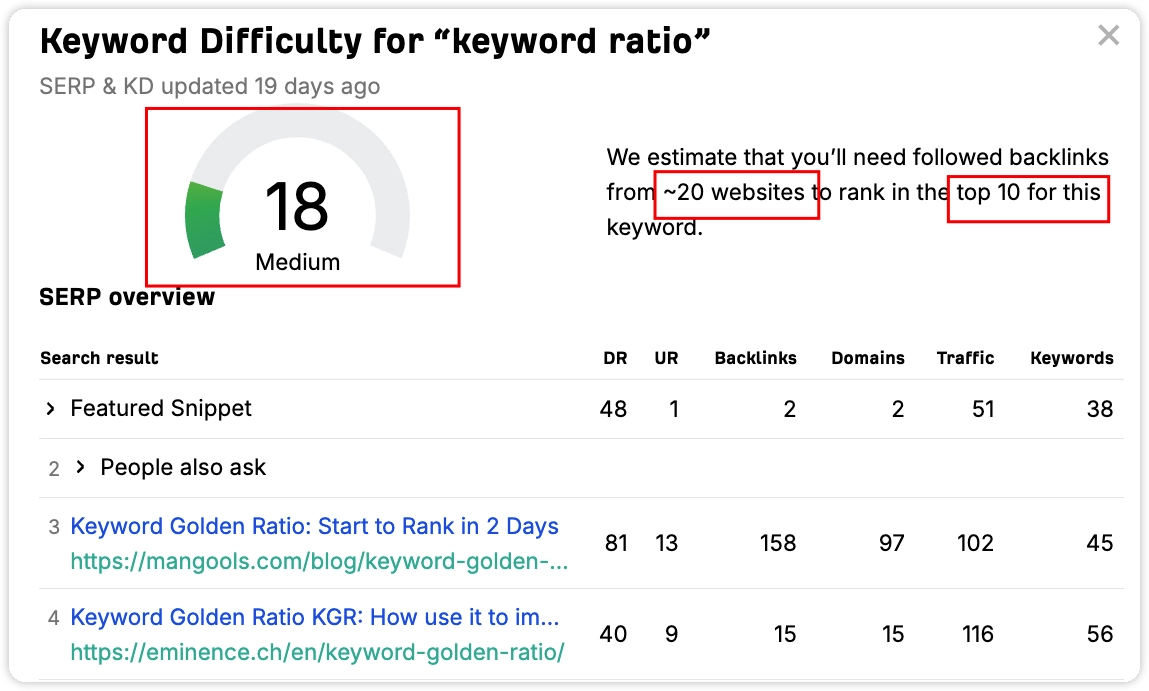 Furthermore, the Keyword Difficulty (KD) value for "keyword ratio" is 18, suggesting that achieving a prominent placement for this keyword presents a moderate challenge.
Furthermore, the Keyword Difficulty (KD) value for "keyword ratio" is 18, suggesting that achieving a prominent placement for this keyword presents a moderate challenge.
Additional Examples of Comparable KGR Keywords:
For the search term allintitle:keywords golden ratio, we get 338 results, with a monthly search volume that's below 250. The calculated KGR is 338 divided by 250, which equals 1.352. This is not ideal as it significantly exceeds the threshold of 0.25.
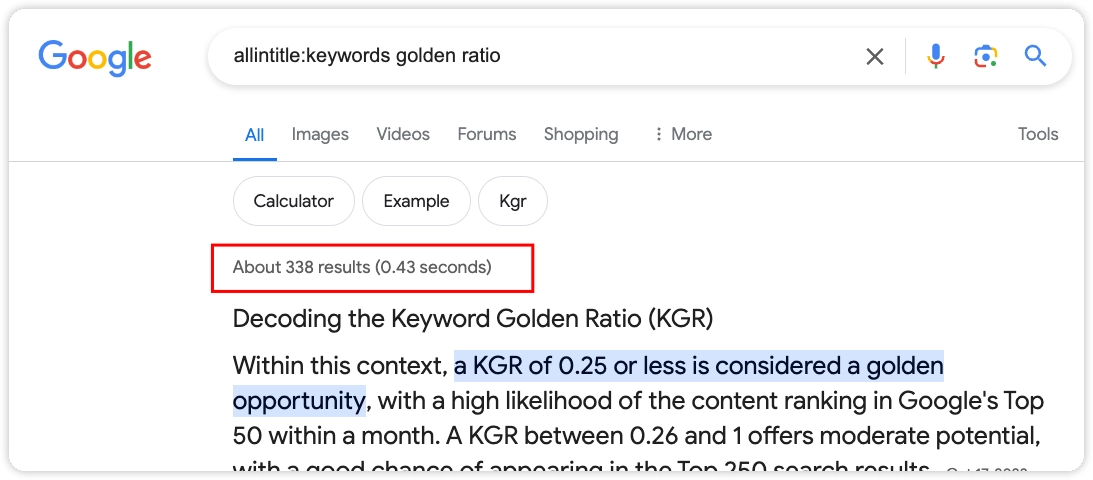
On the other hand, allintitle:keyword golden ratio calculator results in 52, and with a monthly search volume also below 250, the KGR comes to 52 divided by 250, which equals 0.208. This is favorable as it is less than 0.25.
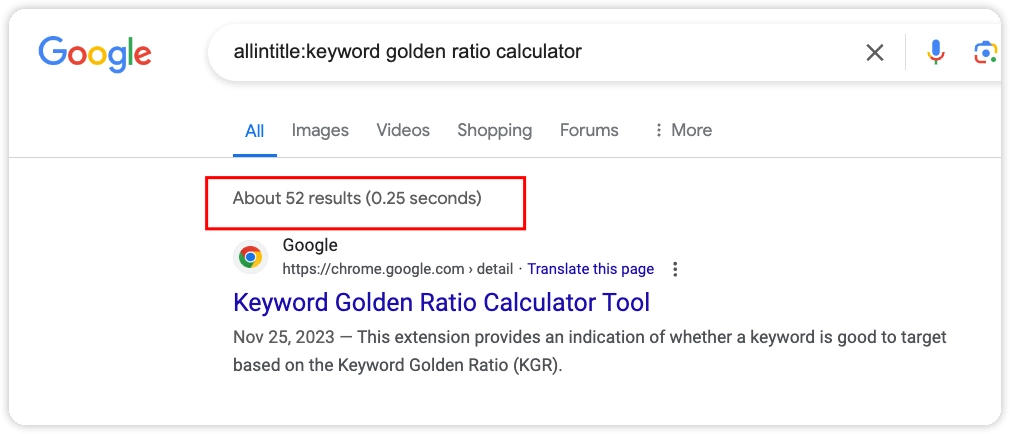
Now, are you getting the hang of it? With a knowing wink, I'll be employing keyword golden ratio calculator as the KGR keyword for this piece.
Conclusion
While "keyword ratio" might not represent the quintessential KGR keyword, there is scope for bolstering our website's SEO through advanced keyword research and refining our content strategy.
In the forthcoming section, we will address strategies to prevent keyword stuffing and discuss methods to effectively integrate keywords, thereby enhancing the content's natural appeal and SEO potency.
Key Considerations for KGR Optimization
When employing KGR for SEO, adhere to several critical guidelines to guarantee that your strategy is both potent and aligned with search engine optimization best practices.
Evading Keyword Stuffing
Keyword stuffing, an overuse of keywords that can result in search engine penalties, is an unethical SEO practice to be avoided. Here's how to steer clear:
- Organic Integration: Keywords should flow organically within the content, avoiding forced inclusions or overuse.
- Balanced Density: Aim for a keyword density that feels natural, with a commonly accepted range between 2% and 5%.
- No Keyword Clusters: Refrain from clustering the same keywords repeatedly, as this can be flagged as spammy behavior by search engines.
Utilizing Keywords Naturally
- Contextual Relevance: Ensure keywords are pertinent to the surrounding content, adding depth to the material.
- Term Diversity: Incorporate a variety of terms, including synonyms and related phrases, to enrich content and improve reader engagement.
SEO Enhancement Tips
- URLs and Titles: Strategically place keywords within URLs and titles to boost the page's search visibility.
- Superior Content: Prioritize producing high-quality content that offers genuine value to users, the cornerstone of successful SEO.
Cautionary Advice
- Algorithmic Shifts: With search engines regularly refining their algorithms, over-optimization can be penalized. Stay abreast of the latest SEO best practices.
- User Experience: Never compromise user experience in the pursuit of SEO; content should be both engaging and accessible to users for sustained success.
By following these principles, you can elevate your website's SEO standing while sidestepping potential pitfalls and maintaining a harmonious approach to user and search engine relations.
In the forthcoming segment, we will explore optimizing your site by experimenting with various KGR examples and making informed choices on the most effective KGR keywords through comparative analysis.
KGR's Extended Applications: Assessing the Viability of Market Demands
Beyond SEO optimization for targeted keywords, KGR can also act as a valuable instrument for testing and validating the potential and market interest of specific demand directions. Here's how you can utilize KGR for this purpose:
Pinpoint Core Keywords
- Identify Central Keywords: Begin by pinpointing the primary core keywords associated with your area of interest. For instance, if you're delving into the realm of artificial intelligence, "AI" or "machine learning" could be your central keywords.
Harness the "allintitle:" Operator
- Execute "allintitle:" Searches: Leverage Google's
allintitle:operator to uncover the number of web pages that include your core keyword. This step offers insights into the competitive intensity of your chosen demand direction.
Secure Search Volume Insights
- Gather Monthly Search Volume Data: Deploy SEO tools to ascertain the monthly search volume for your core keyword. Understanding this metric is crucial for gauging the market's interest in your demand direction.
Determine the KGR Score
- Compute the KGR Value: Apply the KGR formula, integrating the title result count and monthly search volume data you've gathered, to calculate the KGR score.
Evaluate the KGR Score
- Assess the KGR Outcome: Review the KGR score to evaluate the viability of the demand direction. A KGR score within an acceptable range may suggest that the direction merits deeper investigation.
Factor in Market Dynamics
- Analyze Market Trends: Take into account current market trends and consumer behavior to assess if your demand direction is in sync with market movements.
Case Study Examination
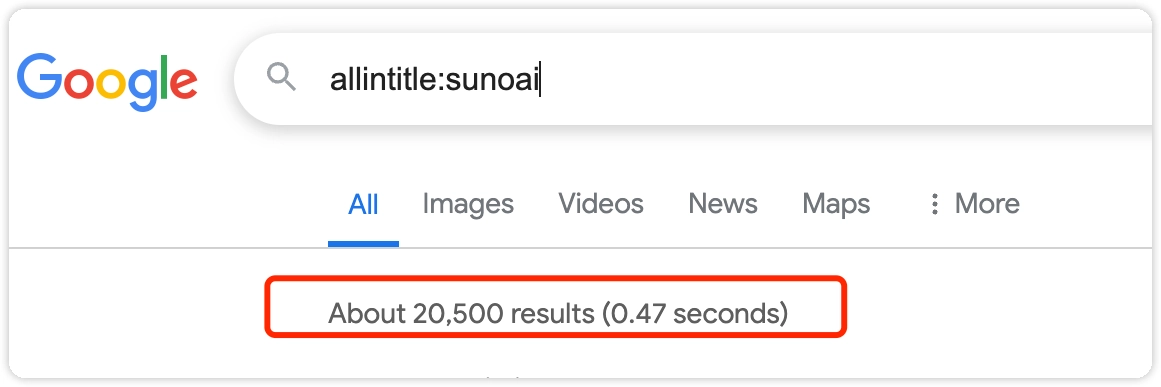
Consider "sunoai" as an illustrative example and follow these analytical steps:
- Central Keyword: "sunoai" is designated as the central keyword.
- Search Outcomes: A search using
allintitle:sunoaireturns 20,500 pages. - Monthly Search Volume: Let's assume the monthly search volume is 60,000.
- Calculate KGR: KGR = 20500/60000 = 0.34
- Analysis of Findings: With a KGR score of 0.34, which is between 0.25 and 1.00, it indicates that while there's potential in this direction, competition is also a factor to consider.
Conclusion
KGR analysis can swiftly uncover and affirm potential demand directions, offering empirical support for your market research endeavors and product development strategies.
In the upcoming section, we will explore strategies for identifying suitable keywords for KGR optimization, including the use of tools such as Google Autosuggest and Ahrefs's Free Keyword Generator.
Identifying Ideal Keywords for KGR Optimization
Unearthing and selecting the optimal keywords for KGR enhancement is pivotal to achieving SEO success. Below are several strategies and tools that can assist you in uncovering these valuable keywords:
Google Autosuggest
- Current Trends: Google's autosuggest feature provides up-to-date keyword recommendations, reflecting what users are currently searching for.
- Utilization: Type your seed keyword into the Google search bar and examine the suggestions presented in the dropdown; these could be prospective KGR keywords.
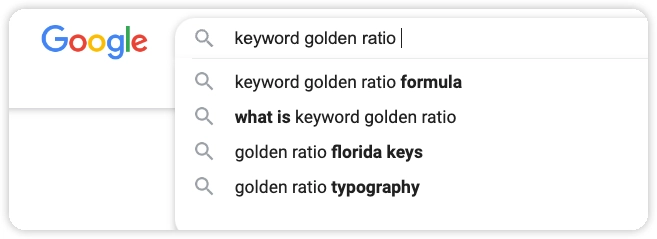
Ahrefs' Free Keyword Generator
- Thorough Analysis: Ahrefs' Free Keyword Generator delivers comprehensive keyword insights, encompassing search volume, keyword density, and competition levels.
- Application: Enter your seed keyword, and Ahrefs will furnish a list of associated keywords complete with their search volume and other relevant metrics.

Semrush's Keyword Magic Tools
- Extensive Capabilities: Semrush's Keyword Magic Tools offer an expansive array of keyword suggestions and analytical capabilities.
- Process: With the Semrush tool, you can generate a list of related keywords based on your seed keyword and evaluate their SEO potential.

Additional SEO Tools
- Tool Diversity: Beyond the mentioned tools, a variety of other SEO tools such as Ubersuggest, Moz Keyword Explorer, and more, also provide keyword suggestion functionalities.
- Holistic Assessment: Different tools may offer varied keyword suggestions. It's essential to assess these suggestions holistically and select the keywords that are most aligned with your website and content strategy.
User-Generated Content
- Community Insights: Explore communities, forums, and Q&A websites related to your website's theme to identify user discussions that could spark keyword ideas.
- Social Media Trends: Popular discussions and hashtags on social media platforms can also be a goldmine for uncovering potential KGR keywords.
Analyzing Content
- Existing Content Review: Assess the current content on your website to pinpoint keywords that are ranking well, signaling opportunities for content expansion.
- Competitive Analysis: Delve into the content strategies of your competitors to understand their targeted keywords and identify related keywords that may not be saturated.
Employing these methods, you can compile a robust collection of KGR keywords that will significantly bolster your SEO efforts.
In the subsequent section, we will examine the pros and cons of KGR to assist you in making a well-rounded evaluation of this strategy and guide your decision-making process.
Weighing the Pros and Cons of KGR
Like any SEO approach, KGR comes with its own set of benefits and drawbacks. Gaining insight into these can assist you in making a more strategic decision on integrating KGR into your SEO roadmap.
Benefits
-
Swift Outcomes: The KGR strategy is engineered to swiftly drive organic traffic, ideal for new or smaller websites aiming to enhance their search presence rapidly.
-
Ease for Novices: KGR provides an accessible entry point for those new to SEO, offering a clear framework for keyword selection and optimization without the need for advanced SEO knowledge.
-
Content Relevance: KGR promotes a focus on crafting content that closely aligns with targeted keywords, which can bolster both content quality and user engagement.
-
Market Gaps: By zeroing in on underrepresented keywords, KGR can enable website owners to address unmet content needs within the market, drawing in search queries that are underserved.
Drawbacks
-
Content Generation Hurdles: With KGR keywords often featuring lower search volumes, a substantial volume of content may be required to boost website authority, which can demand significant investment in time and resources.
-
Subject Constraints: KGR may not be suitable for all subjects or sectors, particularly those with minimal or negligible search volumes.
-
Dependency on Tools: The effectiveness of KGR relies on third-party SEO tools, which can introduce variability in accuracy and reliability, potentially impacting the strategy's success.
-
Algorithmic Volatility: The ever-changing nature of search engine algorithms can affect the efficacy of KGR keywords, requiring vigilant monitoring and responsive strategy adjustments.
A Balanced View
-
Holistic Assessment: When contemplating the adoption of KGR, it's important to weigh its benefits against its drawbacks, taking into account your available resources, timeframe, and content creation prowess.
-
Ongoing Education: SEO is a dynamic landscape, and staying abreast of the latest best practices and algorithmic shifts is essential for sustained SEO achievements.
Understanding the full spectrum of KGR's pros and cons will enable you to make a more educated evaluation of this strategy and skillfully incorporate it into your broader SEO initiatives.
In the forthcoming segment, we will encapsulate the key facets of KGR and offer supplementary resources to inspire further exploration into the realms of SEO and KGR methodologies.